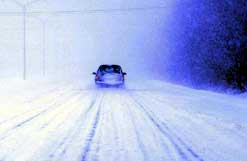An academic from Aberdeen University has developed a computer-generated weather-forecast system aimed at helping local authorities improve road-gritting services during the winter months.
The RoadSafe system can provide council road maintenance teams with the up-to-date and accurate information they require regarding which roads need to be gritted in their area and when.
It is hoped that the system could be used to help prevent and reduce road traffic accidents caused by harsh weather conditions.
RoadSafe was developed by Aberdeen University PhD student Ross Turner, who worked in partnership with Banchory-based weather-forecasting organisation Aerospace and Marine International (AMI) to create the system using technology developed by the institution's Department of Computing Science.
Traditional weather forecasting is based on simulation models that produce weather information presented in the form of tables and graphs, which are then passed directly to a human forecaster to be analysed and drafted into a weather summary.
The RoadSafe system takes these tables and graphs and creates a simple draft text summary for the forecaster, using a standard system of terminology to describe different weather conditions.
The system has already been piloted in live trials with weather forecasters at AMI during their winter road-maintenance operations. Operational staff at various local authorities throughout the UK have also evaluated the system, reporting positive feedback.

Turner said: 'The aim of RoadSafe is to improve road conditions over the winter season by speeding up the delivery and enhancing the efficiency of the weather information that is passed on to council road-maintenance departments.
'The system analyses the computer-simulated weather-forecast information and produces a draft forecast text. It uses what is known as natural-language generation technology to break down the computer-generated forecast into a standardised language where the same terminology is used every single time. This summary is then passed on to the weather forecaster for editing and then issued to road-maintenance departments.
'Forecasters are faced with the task of analysing huge amounts of data in very short periods of time, automating the writing and basic data analysis aspects of the task, allowing them to spend more time ensuring the content is correct.'
James Brownhill, director of business development at AMI, said: 'There are many challenges in providing weather forecasts to, for instance, the general public, high-risk industries like offshore oil exploration or critical safety operations such as the prevention of ice on our highways.
'One challenge is to provide accurate forecasts and that is strictly in the hands of the meteorological community where massive numerical models of the atmosphere have had great success, but these same models provide a huge volume of information,' he continued. 'Consequently, the operational meteorologist is challenged with converting the model's numbers in a timely manner into a forecast that can be correctly interpreted by the end user.
'A forecast received late or a forecast received but misinterpreted can have fatal consequences with respect to gritting our highways.
'Although there has been a tendency to present forecast weather information in graphical form - and this is preferred by the end user - research shows that the most accurate interpretation by the human brain is achieved through reading textual forecasts,' Brownhill added.
RoadSafe addresses all these challenges, the volumes of numerical model data, the speed of preparation of the forecast and the presentation of the forecast in text and graphical form delivered to the user by a communication channel.
It is hoped that the service can evolve in the future into a text-alert system whereby road-maintenance personnel would receive the latest weather information via their mobile.
'There are many potential ways in which this technology can help to further speed up the delivery of information to ground-level road maintenance staff. This includes text-alert systems that would involve those actually operating the gritting vehicles receiving messages via their mobile phones to alert them to where they need to be operating during their shift as the weather develops,' Turner added.




Poll: Should the UK’s railways be renationalised?
Rail passenger numbers declined from 1.27 million in 1946 to 735,000 in 1994 a fall of 42% over 49 years. In 2019 the last pre-Covid year the number...